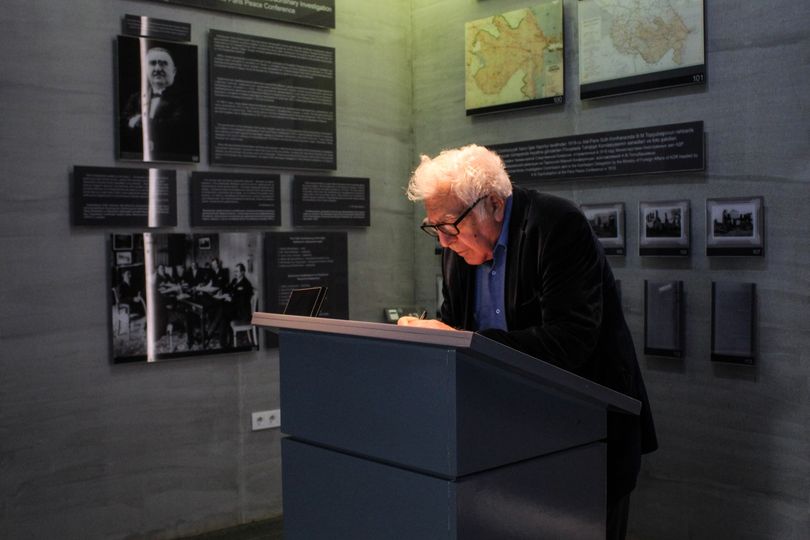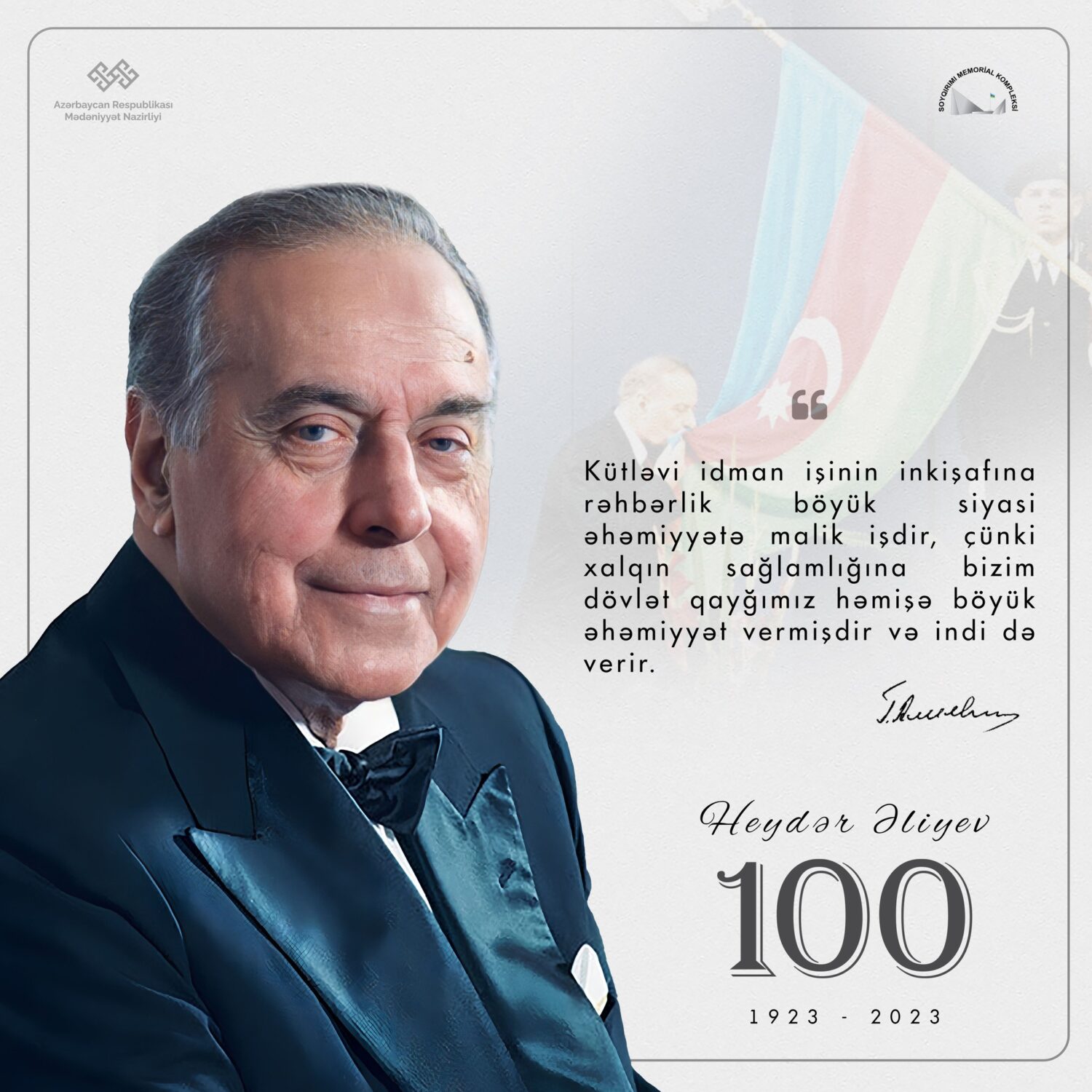
The Azerbaijan National Art Museum, established in 1936, is one of the largest museums in Azerbaijan. Since 1943, the museum has been named after Rustam Mustafayev, one of the pioneers of realistic theater and decorative art. It houses an impressive collection of over 18,000 exhibits.

Heydər Əliyev – 100

Poet, translator, screenwriter, chairman of Azerbaijan Writers' Union Anar (Anar Rasul oglu Rzayev) visited the "Genocide Memorial Complex" in Guba.

After Heydar Aliyev returned to power as the national leader, the development of sports and physical education in Azerbaijan became one of the most important branches of the state's strategy.

In 1994, the Ministry of Youth and Sports was established by the Supreme Leader’s decree to implement the state’s sports policy. The future priorities were determined in the direction of eliminating the problems faced by sports, improving the financial well-being of athletes, and creating new sports complexes in the country.
On March 5, 1995, Heydar Aliyev signed a new decree establishing a fund under the President of Azerbaijan to promote a healthy lifestyle among the population of the Republic of Azerbaijan and to develop the material and technical base of physical education. The aim was to create a solid foundation for the internationalization of Azerbaijani sports.
Today, thanks to the high state attention given to the development of sports, Azerbaijani athletes represent the country with dignity in prestigious world competitions and the Olympic Games, increasing their success year by year.
Heydar Aliyev, the genius who saved Azerbaijan from inevitable disaster with his return to power in 1993, and initiated the fateful changes in the country's political and economic life, began to make important decisions and measures for this rise.

Under the leadership of national leader Heydar Aliyev, on September 20, 1994, one of the most important agreements in the history of Azerbaijan in the 20th century due to its political, economic and strategic importance – the joint development and production of a part of the Azeri-Chirag-Guneshli oil field located in the Azerbaijani sector of the Caspian Sea. Agreement on share distribution – “Contract of the Century” was signed. 11 international oil companies (Amoco, BP, McDermott, UNOCAL, SOCAR, Lukoil, Statoil) representing 7 countries of the world (Azerbaijan, USA, Great Britain, Russia, Turkey, Norway and Saudi Arabia) in the “Deal of the Century” worth 7.4 billion dollars , Turkish Petrollari, Pennzoil, Ramco, Delta) participated.
People have always been united by spirituality, as moral principles are considered to be superior to other principles.

The army is one of the constituent parts of state forming as the main force for ensuring the territorial integrity of the state.

Although modern Azerbaijan achieved the restoration of state independence in 1991, the creation of the army became possible after national leader Heydar Aliyev returned to power in 1993 at the insistence of the people. After national leader Heydar Aliyev returned to power for the second time, the National Army was formed, urgent measures were taken to establish the regular Armed Forces of Azerbaijan, and military discipline was strengthened. Having an army that is fully capable of protecting the sovereignty, independence, and territorial integrity of Azerbaijan today can be considered one of the unparalleled services rendered by Heydar Aliyev to the people of Azerbaijan.
The formation of Guba as a fruit-growing region is connected with the name of the national leader Heydar Aliyev.

During the years when the great leader led Azerbaijan, the development of horticulture in our republic, especially in Guba, became an integral part of state policy. It was on his initiative that in 1974, the adoption of the government decision on “Measures for the further development of fruit growing based on intensification and specialization” was the beginning of a new stage in the development of horticulture in Azerbaijan.
After this decision, important steps were taken to regulate and further develop the republic’s economy, and within a few years, 14,000 hectares of new intensive gardens were built in Guba. It should be recalled that until that time there was no such intensive garden area in any region of Azerbaijan.
The national leader invited experts from former Soviet republics to Guba. In 1983-1984, an average of 450-500 quintals of crops were collected from each hectare of gardens. In 1984, Guba gardeners managed to collect more than 100 thousand tons of fruits for the first time in the history of the region.
In the first years following the restoration of independence, when agrarian reforms were started in our country at the initiative of the great leader Heydar Aliyev, there were 37 collective farms, state farms and other state enterprises of this type in Guba. As a result of the reform, 13,424 hectares of orchards belonging to those enterprises were transferred to the private ownership of citizens. Currently, there are about 17 thousand hectares of orchards in Guba. 13 thousand hectares of it are apple orchards.
Ölkəmizdə muzey işinin təşəkkülü və inkişafı Ümummilli lider Heydər Əliyevin adı ilə bağlıdır.

Fictional "Armenian genocide" and historical truth

Armenians have always “hunted” for land in the territories of other nations in order to create a national institution for themselves. This attempt did not bring them any success for a long time. Armenian authors themselves say that this ethnos is a society born from a hybrid of different ethnic groups in Mesopotamia before BC. Then Armenians gradually began to appear in the Asia Minor peninsula. Trying to show themselves as “hosts”, these creatures headed to the Balkans. However, they behaved inappropriately there as well, and were expelled from there due to their misbehavior. The soft-hearted Turkish-Muslim people gave them the possible shelter, even though they were on mountains and rocks. After that, the migration of Armenians to the South Caucasus began gradually, from time to time. April 24 – where does fictional “Armenian Genocide” day come from? Armenian author Akop Keshishyan evaluates it as follows: “We were all saddened by the declaration of April 24 as the day of the Armenian massacre by the Orthodox Church in Beirut, incited by the Greeks. Let us inform you that the term “Armenian genocide” was coined by the Armenian church in the 50s of the last century and later turned into a big campaign with the support of the Armenian lobby. The pro-Armenian forces try to take advantage of those events as a tool even today. In fact, at that time, there were not as many Armenians as were allegedly killed in Turkey. Although some Armenian historians say that this number is 600 thousand, and some 1 million, Russian sources write that this number is 2 million, knowing that this is a lie. The variety of figures given by Armenian and Russian writers regarding the “Armenian genocide” of 1915 is a clear proof that this event is a artifice. Turkish scientists have conducted a lot of serious research in the last ten years. One fact can be cited from these studies that the names, surnames and documents of many Armenians, whose names were mentioned during the resettlement movement in 1915, presented by Armenians, were officially released from other places in 1916-1917-1918. However, the Armenians wrote them as having died in the events of April 1915. But we must not forget one fact that if 1.5 million Armenians had been killed at that time, there would have been one or two Armenians left in the world today.”
Fictional “Armenian genocide” never happened in Turkey in 1915. This is nothing but a manifestation of the jealous attitude and prejudice of the major world powers towards the growing economic power and international influence of the Turkic world, towards the Turkish race, and an Armenian fabrication!











